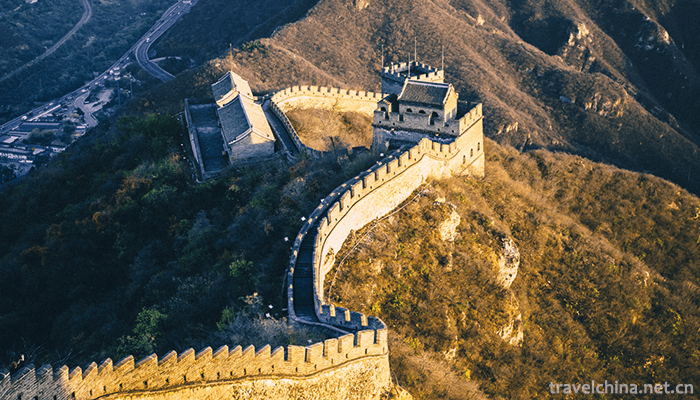The Gu Guan Great Wall
the Gu Guan Great Wall
Guguan Great Wall is located in Xinguancun, Pingding County, Shanxi Province, on the western side of Taihang. It starts at Niangziguan Jiayugou in the north and reaches Baihui Village in the south. It is an important pass of the Great Wall. Guguan Great Wall is the only existing stone-lined Great Wall in China, which is the earliest Great Wall in Ming Dynasty. Luo Zhewen, a famous expert on the Great Wall, calls it "the charm of Xiaobadaling". According to Mr. Luo's textual research, the Guguan Great Wall was built in 369 B.C., 155 years earlier than the Great Wall built after the unification of the Six Kingdoms by Qin Shihuang. Although most of the existing relics are Ming Dynasty buildings, it has a history of 2374 years since its inception, which is rare in China.
Guguan is one of the four famous Guans in the west of Beijing in the Ming Dynasty (the other three Guans are Juyong Guan, Bauhinia Guan and Qianma Guan), which is the "Jingji Fanping". Guancheng was first built in the second year of Ming orthodoxy (1437). It was called "Guguan" at that time. It was built in Jiuguan Village, Niangziguan Town, Pingding County. In the 22nd year of Jiajing (1543), although Taiyuan was close to the Pass, the old city was in danger of being insufficient. So he moved ten miles west to build a new city. He changed the meaning of "Guruojin Tang" to "Guruojin Tang", and later restored the Great Wall on both sides of the Pass. Lushi Spring and Autumn Period refers to one of the "Nine Seizures under Heaven".
geographical position
Guguan Great Wall is located 35 kilometers east of Pingding County, only 2 kilometers away from the junction of Shanxi and Hebei. It is the east gate of Shanxi, 65 kilometers east of Shijiazhuang and 50 kilometers west of Yangquan. Taijiu Expressway and 307 National Highway intersect from here. The traffic is very convenient. They belong to Xinguancun, Niangziguan Town, Pingding County, Shanxi Province.
Basic introduction
History
Guguan has experienced many important historical events, and there are many emperors, generals and officials, literati and Mohists who come and go there in successive dynasties. For example, King Qin cut down the corpses of Zhao and Qin Shihuang and returned to Xianyang, Han Xin's "Battle of Backwater". Guo Ziyi and Li Guangbi calmed down the "Anshi Rebellion". Emperor Kangxi's Western Tour passed through here. Han Yu, Sima Guang, Han Qi, Yu Chenglong, Kong Shangren and others also left excellent poems here.
The Great Wall of Guguan was destroyed by wars and war for a long time. In addition, in the twenty-first year of the Republic of China (A.D. 1932), a simple highway was built. After the founding of the People's Republic of China, 307 National Highway and Taijiu Highway were built across the ancient Great Wall, which inevitably damaged this important cultural relic and monument. After 1998, with the support of superiors and under the guidance of cultural relics experts, Xinguancun, with only 600 people, restored thousands of meters of ancient Great Wall and sentry, Yalou Building, Pharmaceutical Building, Guanmen, Xifeng Temple, 307 National Highway Bridge, Taijiu Expressway Bridge and reappeared the style of Xiongguan Ancient Road at both ends of Guguan by volunteer workers and voluntary donations.
At the end of the Qing Dynasty, Guguan was still intact and its monuments were not damaged. Later, Guguan was subjected to repeated wars and unregulated collapse and disrepair. Especially during the Cultural Revolution, the damage was serious, and ancient buildings such as Forts of city walls were demolished at will. Now, there is only one complete fort, three and a half, and the rest is only a low base; the city buildings are falling, the Yamen and the temples are all demolished, almost in ruins. The old Guguan city can only be seen now.
repair
In October 1998, the first phase of Guguan Great Wall project started smoothly. In order to restore the style of the Great Wall, women and children went to battle, eating pot pulp, fearing hardships and dangers, gathering sand into a tower. It invested 650,000 yuan, of which 240,000 yuan was raised by villagers and 13,000 volunteers. It took nine months to repair 620 meters of the Great Wall in the north, three enemy buildings, two watchtowers on the tower, 150 meters on the ramp and steps, 70 meters on the dam, 30 meters on the guard wall, four hexagonal pavilions in Xifeng Temple and two archway buildings. At the same time, the greening of the west side of the Great Wall was carried out, and the conditions for opening up to tourists were preliminarily met.
The second phase of the project invested 1.5 million yuan to restore the Great Wall across the bridge, Wengcheng, Guanlou and 800 meters of the southern section of the Great Wall of the National Highway. At that time, the confrontation between dangerous buildings and Qingfeng, the dance between ancient roads and Taijiu, the new wind and customs, and the cold iron clothes, also responded to the praise of Professor Luo Zhewen, a famous expert on the Great Wall cultural relics, that the Guguan Great Wall "has the charm of Xiaobadaling".
The ancient Great Wall will stand on the top of Taihang with a brand-new appearance, and the east gate of Shanxi will add a beautiful scenery.
Original name
According to Professor Luo Zhewen, the Great Wall of Guguan, which was built in the Spring and Autumn Period and the Warring States Period in 369 B.C., belongs to the Great Wall of Zhongshan State. It is 155 years earlier than the Great Wall built after the unification of the Six Kingdoms by the First Emperor of Qin. It is the only stone Great Wall in existence in China. From the beginning to today, the ancient Great Wall has gone through more than 2370 years of vicissitudes and battles. It was rebuilt in the 17th year of Wanli in Ming Dynasty (1589). While rebuilding the Great Wall of Guguan, the city was built with three Yamen, commonly known as Dayamen, Eryamen and Sanyamen. Dayamen had three military officers, Emperor Jiajing's fourth uncle, Zhuangyi King, sitting in the town to command; the second Yamen was located in the back street, and the General was responsible for military affairs; the third Yamen was located near Guguanguan Pass, responsible for guarding and collecting customs duties. During the Ming and Qing Dynasties, Guguan was the only way to Beijing. Its terrain was dangerous, and it was the strongest point to protect Beijing. It was one of the eight longs in Taihang and Jiusai in the pre-Qin period. Juyong Pass, Baujingguan Pass, Shuimaguan Pass and Guguan Pass are the four famous passes in the west of Beijing in the Ming and Qing Dynasties, and they are also "Jingji Fanping".
During the Jiajing period of the Ming Dynasty, nomadic bandits in Inner Mongolia often fled to the interior to disrupt, led the army to attack the old customs (the present and the old customs). Because of the insufficient terrain, they were almost overthrown by the bandits. In order to strengthen the defense, Emperor Jiajing ordered to move the Pass and set up a city. The governor of Zhengding Zhili requisitioned more than 2,000 migrant workers from eight counties. He moved Guguan to the west to build a pass and changed it to Guguan, which is now Guguan. This is the origin of Guguan's name. After the overthrow of the Qing Dynasty, Guguan was changed to Xinguancun due to the change of place names.


-
2.Jiaying Scenic Spot
Jiayingguan, commonly known as the Longwang Temple of the Yellow River, is located in Jiayingguan Township, Wuzhong County, Jiaozuo City, Henan Province, China
Time 2019-01-21 -
3.Wuhan Haichang Polar Ocean World
Wuhan Haichang Polar Ocean Park is the first Ocean Park constructed by Haichang Group in central China. It is the fifth large-scale theme park covering the concept of polar and ocean
Time 2019-02-24 -
4.Chentang Sherpa Singing and Dancing
Chen Tang Sherpa Song and Dance is a traditional folk song and dance in the Sherpa community of Tibet. Accompanied by "Zhanlie" (Six Strings) and "Biwang" (Huqin).
Time 2019-04-16 -
5.GUI Opera
Gui Opera (commonly known as Gui Opera or Gui Ban Opera), Guangxi local traditional drama, one of the national intangible cultural heritage.
Time 2019-05-02 -
6.Shanghai Opera
Shanghai Opera, a local traditional drama in Shanghai, is one of the national intangible cultural heritage.
Time 2019-05-03 -
7.Huidong Fishing Song
Huidong Fishing Song is one of the traditional folk arts in Guangdong Province. From the Song Dynasty, fishing songs in the shallow sea of Huidong were introduced from the coast of Fujian Province.
Time 2019-05-05 -
8.Legend of Liu Bowen
Liu Bowen's legend is based on the traditional folk oral literature of Liu Ji, a historical figure, spread throughout the whole country in eastern Zhejiang, with Qingtian, Wencheng and other southern
Time 2019-05-13 -
9.Taoist Music of Xuanmiaoguan in Suzhou
The Taoist music of Suzhou, represented by the Taoist music of Xuanmiaoguan, belongs to the Zhengyi Taoist music, and is an integral art with the performing process of Zhai Yin Fa. It sings different
Time 2019-06-17 -
10.Back to back entanglement
Tongbei Bianquan, also known as Hongdong Tongbeiquan, is a complete and systematic set of traditional boxing. It combines the advantages of both inside and outside. It is divided into mother boxing an
Time 2019-06-21 -
11.Deyang tertiary industry
In 2018, the annual real estate development investment in Deyang City was 14.98 billion yuan, an increase of 42.6% over the previous year. The construction area of commercial housing was 15.827 million square meters, an increase of 24.9%; the completed area
Time 2020-12-14 -
12.Yibin secondary industry
In 2019, the total industrial added value of Yibin City is 99.082 billion yuan, an increase of 9.5% over the previous year, and its contribution rate to economic growth is 45.5%. At the end of the year, there were 824 Industrial Enterprises above Designated Si
Time 2020-12-18